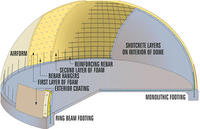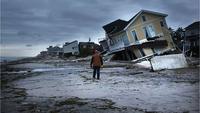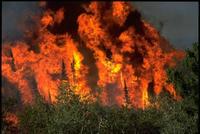-
Larger fire-fighting crews save lives, limit damage in high-rise fires
Between 2005 and 2009 there were, on average, 15,700 high-rise structure fires annually in the United States. Average annual losses totaled 53 civilian deaths, 546 civilian injuries, and $235 million in property damage. When responding to fires in high-rise buildings, firefighting crews of five or six members — instead of three or four — are significantly faster in putting out fires and completing search-and-rescue operations, concludes a major new study.
-
-
Aging national power grid leaves U.S. vulnerable to storm-related outages
In parts of the United States where the grid system is “out in the open” and exposed to the elements — especially in our older cities — the risk increases for widespread power outages as a result of weather-related events, leading to lengthy, costly repairs.
-
-
Direct CO2 removal could lower costs of climate mitigation
Two broad strategies are typically offered to protect infrastructure from the consequences of climate change: reducing to emissions of CO2 into the atmosphere by using less fossil fuels, and mitigation (building sea walls, dams, and levees; changing building codes, etc.). Both approaches are costly. Scientists suggest that directly removing CO2 from the air could alter the costs of climate change mitigation. It could allow prolonging greenhouse-gas emissions from sectors like transport which are difficult, and thus expensive, to turn away from using fossil fuels.
-
-
New Jersey to launch emergency, preparedness awareness campaign
The New Jersey Office of Homeland Security and Preparedness is currently looking for a PR firm to help it launch a multifaceted awareness campaign. The campaign, worth about $4 million over three years, would aim to increase the level of emergency awareness and preparedness of residents, businesses, and communities in New Jersey.
-
-
Mississippi towns build tornado-proof domes

Following a devastating tornado two years ago, the town of Smithville, Mississippi, has started construction on a tornado-proof dome. The dome, to be built on the grounds of the local high school, will double as a gym and a storm shelter. Other towns in Mississippi have also begun their own dome projects.
-
-
L.A County to turn rain water into drinking water
Residents of Los Angeles County know that on the rare occasion that it rains, staying away from the beach is a good idea. Runoff from rain typically brings heavy metals, pesticides, cigarette butts, animal waste, and other pollutants into the streams and rivers which go into the Pacific Ocean. Now, local officials are getting together to find a solution to the water pollution and water scarcity, with an ambitious plan to make the runoff water drinkable.
-
-
New device will quickly detect botulinum, ricin, other biothreat agents
Researchers are developing a medical instrument which will be able quickly to detect a suite of biothreat agents, including anthrax, ricin, botulinum, shiga, and SEB toxin. The device, once developed, approved by the Food and Drug Administration (FDA), and commercialized, would most likely be used in emergency rooms in the event of a bioterrorism incident.
-
-
Supercomputers allow for more realistic earthquake simulations
A team of researchers has developed a highly scalable computer code that promises dramatically to cut both research times and energy costs in simulating seismic hazards throughout California and elsewhere. The team performed GPU-based benchmark simulations of the 5.4 magnitude earthquake that occurred in July 2008 below Chino Hills, near Los Angeles.
-
-
Oregon citizens preparing for the Big One

A new study concludes that an earthquake of a magnitude 8.0 or above will strike off the coast of the state within the next fifty years. The Cascadia Fault, which runs from Northern California to British Columbia, Canada, causes a massive earthquake every 300 years or so, and the last time an earthquake hit the region was in the year 1700.
-
-
UN event highlights importance of mobile technology during disasters
A United Nations event, organized in conjunction with the Turkish government, the other day highlighted the role of innovative mobile technology in saving lives when conflicts and disasters strike.
-
-
DHS launches Campus Resilience pilot program
DHS secretary Janet Napolitano announced Tuesday that seven universities will participate in a national preparedness initiative designed to help campuses train for, respond to, and recover from an emergency situation.
-
-
Americans support preparation for extreme weather, coastal challenges: survey
The challenges posed by rising sea levels and increasingly severe storms will only intensify as more Americans build along the coasts. A just-released NOAA report predicts that already crowded U.S. coastlines will become home to an additional eleven million people by 2020. A Stanford survey finds that the majority of Americans support stronger coastal development codes. Among the most popular policy solutions: stronger building codes for new structures along the coast to minimize damage, and preventing new buildings from being built near the coast.
-
-
U.S. suffered $119 billion in disaster-related losses in 2012

Natural and man-made disasters contributed to $186 billion in economic losses around the world last year. The United States took the biggest hit with $119 billion in losses. Insurance claims for weather-related losses in 2012 totaled $77 billion dollars, the third most expensive losses on record. Nine of the top ten most expensive insured loss events which occurred last year happened in the United States.
-
-
Suppressing naturally occurring blazes increases wildfire risk

According to the National Interagency Fire Center, 9.3 million U.S. acres burned in wildfires in 2012 compared with 3.57 million acres affected in 2001 and 2.95 million in 1991. One reason for the increase in the number of acres consumed by wildfires is the U.S. government’s policy of suppressing of naturally occurring blazes. Researchers say that this policy can have unintended consequences, including making wildfires more severe.
-
-
How U.K. can better prepare for emergencies
Well designed and planned exercises are essential to ensure that the United Kingdom can respond effectively to emergencies of all kinds. The emergencies may take the form of a terrorist attack, flooding, pandemic flu, rail or air disaster — or any major disruptive event requiring an emergency response.
-
More headlines
The long view
Trump Aims to Shut Down State Climate Policies
President Donald Trump has launched an all-out legal attack on states’ authority to set climate change policy. Climate-focused state leaders say his administration has no legal basis to unravel their efforts.
